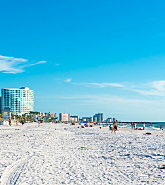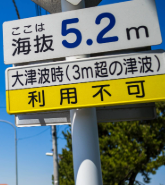The city of Tacloban, on the island of Leyte, is the largest city in the eastern Visayas region of the central Philippines. In a 2010 survey by the Asian Institute of Management, Tacloban was ranked fifth in the “most competitive” cities in the Philippines, and second in the class of “emerging cities.” Before Haiyan’s storm surge, the city was thriving, with only one third the national average poverty levels.
However, from the natural hazards perspective Tacloban would also be high up on a list of the most dangerous medium size cities in the world.
Tacloban faces east into the tropical Pacific where there is the largest, deepest and hottest pool of ocean water on the planet, fuel for cooking up intense super typhoons, and sustaining their intensity all the way to landfall. More significantly the port city is located in the apex (or “armpit”) of a funnel-shaped coastline – where the eastern coast of the island of Leyte meets the southern coast of the island of Samar. Although the 2km wide “San Juanico” channel separates these islands, in a fast westerly moving typhoon, this channel cannot relieve the large dome of water pushed ahead of the storm.
Funnel shaped coastlines are notorious for concentrating and amplifying tropical cyclone storm surges. New York City is situated at the apex of the funnel-shaped coastline where New Jersey meets Long Island, amplifying the surge from Super-storm Sandy. Osaka in Japan is also at the apex of funnel coastline. However intense typhoons pass close to Leyte far more often than intense hurricanes come to New York or Japan.
The ground on which the quarter of a million population city of Tacloban has grown up is remarkably flat and only a meter or two above high tide level. A 4-6 meter storm surge and its accompanying waves can penetrate far inland, ripping houses off their foundations for several blocks, just as happened in the cities along the southern coast of the State of Mississippi in Hurricane Katrina.
Tacloban is built on a former wave-cut platform, at the foot of active cliffs, which has become raised out of the sea by active tectonics. For the city is also located in the frontline of a plate boundary.
Offshore to the east, less than 80km from the neighbouring island of Samar, a deep sea trench, marks where the Philippines Sea plate moves down beneath the Philippines, at around 50mm per year. The 1300 km NNW-SSE Philippines subduction zone appears to be locked, and has not broken in a major earthquake through the past four hundred years, since the start of Spanish colonial rule.
If, as is suspected, the Philippines subduction zone is capable of generating a giant Mw9 earthquake, then this will be accompanied by a large tsunami, as in Sumatra 2004 and Tohoku, Japan in 2011. Tacloban is very much in the frontline of such a tsunami – the biggest city, on low ground, facing the open Pacific. A tsunami at 10 m or more could cause more casualties and destruction even than the 2013 storm surge.
Tacloban city was founded as a fishing village and more recently achieved fame as the birthplace of Imelda Marcos. Some parts of its history are obscure, in particular when it first became a municipality, as the records were all destroyed in a previous typhoon. The name Tacloban has the potential to recur on the list of future catastrophes. Only action in reconstruction, relocating the city away from the low lying coast, can reduce that potential.






